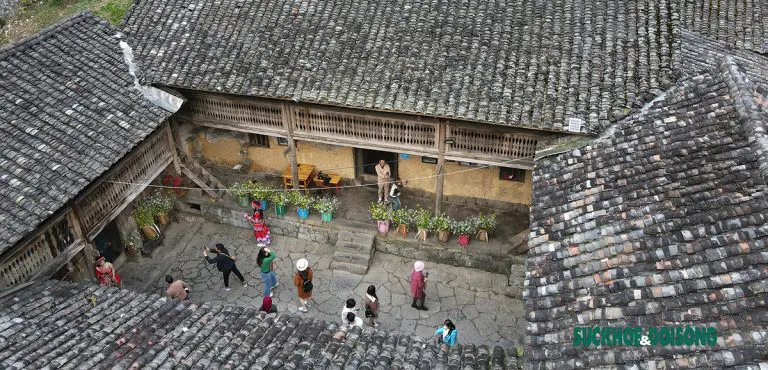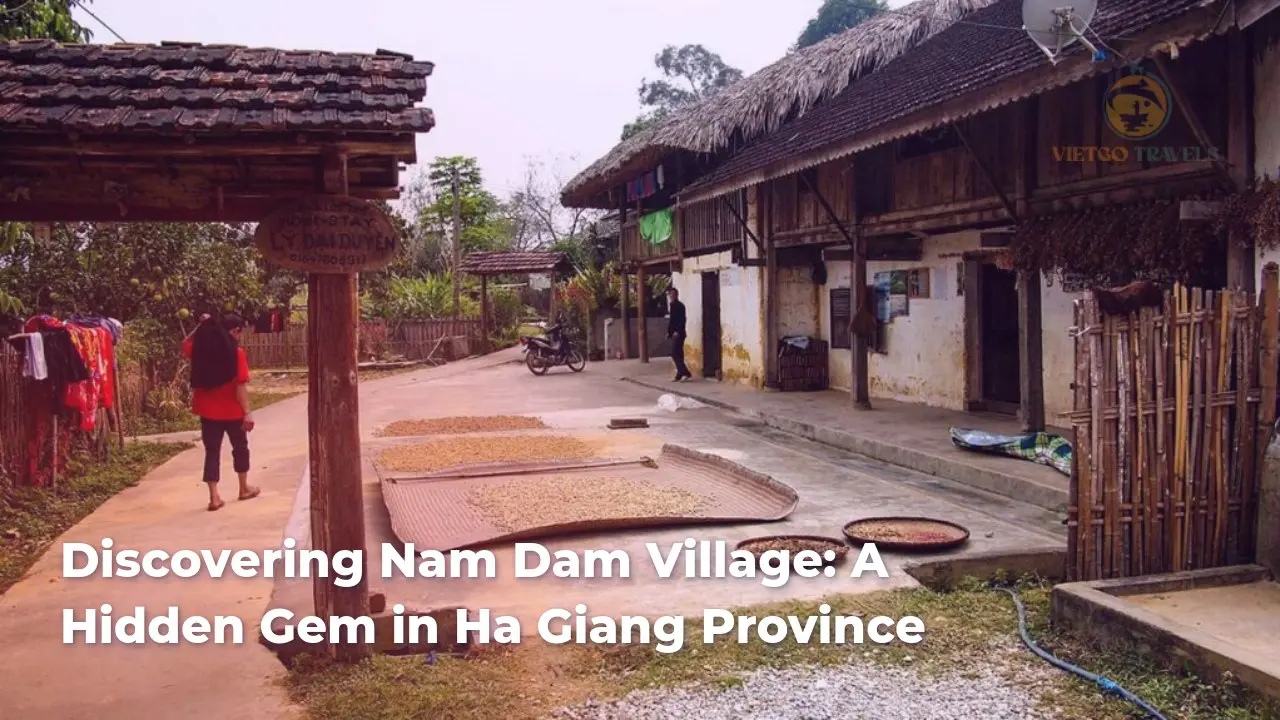
Xin Man, Ha Giang: What Makes This Region Special?
Xin Man district has a complex terrain, located in the upper Chay River mountain range, so it is mainly hills with steep slopes and divided by many streams.
Nestled in the heart of Ha Giang province, Pao’s House is not just a structure; it’s a significant cultural landmark that tells the story of the Hmong people and their rich heritage. Known famously for its appearance in the acclaimed Vietnamese film The Story of Pao (Chuyện của Pao), this house has become a pilgrimage site for fans and a beacon of Hmong culture. Located in the picturesque Lung Cam Cultural Tourism Village, specifically in Dong Van District, Pao’s House beautifully merges its historical significance with stunning architecture and breathtaking scenery, drawing visitors from across the globe.
In exploring Pao’s House, one delves not only into its architectural beauty but also into the profound history and cultural insights it offers. The house provides a glimpse into the traditional lifestyle of the Hmong ethnic group, making it a must-visit for those traveling through the Ha Giang loop. Let’s take a closer look at the various aspects that make Pao’s House an essential destination in Vietnam.

Pao’s House became synonymous with the Hmong culture due to its portrayal in the film The Story of Pao. Built in 1946, this house stands as a testament to the architectural prowess of the Hmong people, showcasing their unique building techniques and lifestyle. The structure is located approximately 122 km from Ha Giang City, making it an accessible stop for travelers exploring the stunning landscapes of northern Vietnam.
The film that catapulted Pao’s House into public consciousness revolves around themes of love, loss, and the struggle of life in a remote village, mirroring the experiences of many locals. Its cultural impact is profound, as the house has since attracted numerous tourists and film enthusiasts eager to witness the setting that brought such poignant narratives to life.
The construction of Pao’s House in 1946 reflects the enduring traditions of the Hmong people. This house showcases traditional architectural styles rooted in a landscape that is both beautiful and rugged. The U-shaped design, with a two-story structure, includes multiple functional areas such as living spaces, kitchens, and storerooms, demonstrating the practicality and lifestyle of its inhabitants.
Moreover, the walls of the house are crafted from compacted earth, a sustainable building material that keeps the interior cool in summer and warm in winter. Wooden columns support the structure, while its tiled roof adds both durability and aesthetic appeal. Surrounding the house is a stone fence, which not only enhances its rustic charm but also serves the practical purpose of delimiting property in the often hilly terrains of Dong Van.

Beyond its architecture, Pao’s House stands as a cultural landmark, symbolizing the resilience and heritage of the Hmong ethnic group. It’s a pilgrimage site for fans of the film, who find inspiration in the stories it tells and the lives it represents. The significance of Pao’s House extends into the realm of education, serving as an informal museum where visitors can learn about Hmong traditions, customs, and daily life.
For those interested in the cultural dynamics of Vietnam, the historical significance of Pao’s House cannot be understated. It represents not just a physical location but also a gathering point for cultural exchange and understanding amongst diverse visitor demographics.
Pao’s House is remarkable for its unique design and construction techniques, which are closely tied to the traditional practices of the Hmong community. The U-shaped layout of the house allows for a natural flow of space, fostering interactions among family members while providing functional living areas suited to life in a mountainous region.
The house is comprised of ** rooms designed for different purposes**, including sleeping quarters, cooking spaces, and storage areas. The use of natural materials not only reduces the environmental impact of construction but also showcases the craftsmanship unique to the Hmong people.
Each aspect of the architecture serves a purpose, imbued with cultural significance. For instance, the layout may symbolize unity and community, reflecting the Hmong’s close-knit family structures. As visitors tour the house, they may notice how the design fosters a sense of belonging and warmth among its inhabitants.
Pao’s House is located about 122 km from Ha Giang City, making it a practical venture for those navigating the Ha Giang Loop. The drive through the loop is famous for its breathtaking views of terraced fields, mountains, and valleys, enriching the experience of visiting this historic site. Travelers can easily include Pao’s House in their itinerary as part of a cultural exploration of the region.
When planning a visit, it’s worth noting the entrance fee is a mere 10,000 VND (approximately $0.41 USD). This nominal fee allows guests to appreciate the beauty and cultural significance of Pao’s House without breaking the bank. The visiting hours stretch from 8 AM to 6 PM daily, providing ample time for exploration and appreciation of the site.
While Pao’s House stands out as a cultural treasure, several nearby attractions enhance the overall experience for visitors. Here are some highlights:
Visitors are encouraged to explore these attractions to gain a comprehensive understanding of the cultural heritage and natural beauty of Ha Giang.

When visiting cultural sites like Pao’s House, it’s crucial to respect local customs and the community. Here are some tips to ensure an enjoyable and respectful experience:
Adhering to these tips not only enriches the visitor experience but also promotes positive interactions between tourists and the Hmong community.
Pao’s House is more than just a tourist attraction; it stands as a vibrant cultural tapestry woven into the lives of the Hmong people. It offers insight into their rich heritage, architecture, and traditions, allowing visitors to connect deeply with the local culture. From its unique design to its historical significance, the house captures the essence of a community that thrives amidst the breathtaking landscapes of Ha Giang. For travelers seeking an authentic cultural experience in Vietnam, Pao’s House is a not-to-be-missed destination that beautifully embodies the spirit of the Hmong people.

Xin Man district has a complex terrain, located in the upper Chay River mountain range, so it is mainly hills with steep slopes and divided by many streams.

Venture into the untamed beauty of northern Vietnam with Vietnam Treasure and discover the magic of Suoi Thau Steppe. This captivating landscape offers a unique blend of cultural immersion and breathtaking natural scenery far from the bustling tourist trails.

Nestled high in the mountainous region of Ha Giang, Phung Village (Ban Phung) is a hidden gem offering a glimpse into the authentic beauty and culture of Northern Vietnam.

Stop at Thong Nguyen Village, and you will discover amazing beauty. This is a rugged and difficult mountainous area. Many people may think that nothing is interesting here. Join Vietnam Treasure to discover the beauty of Thong Nguyen Village.

Its name, Hoàng Su Phì or Hoàng Thụ Bì, means “the yellow bark” in the Hmong language. It indicates the woods of weeping cypress, which is a local specialty.

Hoang Su Phi terraced fields possess an undeniable charm, creating a mesmerizing scene—journey to Ha Giang with Vietnam Treasure to witness the brilliant golden rice harvest season. Although present in many countries, especially in Southeast Asia, terraced fields in Vietnam are deeply associated with the traditional agricultural activities of many ethnic groups in the northern mountainous region, such as the H’Mong, Dao, Nung, La Chi and Ha Nhi.
Tu San Canyon (Mèo Vạc district), the deepest canyon in Vietnam. It has a depth of about 800 m, a length of 1.7 km, and cliffs that slope 70° to 90°.

Discover the culture and beauty of Nam Dam Village, a hidden gem in Vietnam’s Ha Giang Province. Perfect for adventure and culture enthusiasts.
Copyrights @2025 Vietgo Travels. Terms and Conditions Privacy Policy
Hotline
+84 855 452 888 (Viet Nam) / +1 (206) 665 3090 (US)
Email: [email protected]
Website: www.vietgotravels.com
Head Office:
No. 23 Lo Su Street, Hoan Kiem District, Ha Noi, Viet Nam.
Viet Nam’s branch:
No. 35 Hang Quat Street, Hoan Kiem District,
Ha Noi, Viet Nam.
US:
831 41st Pl, Everett, WA 98201, USA